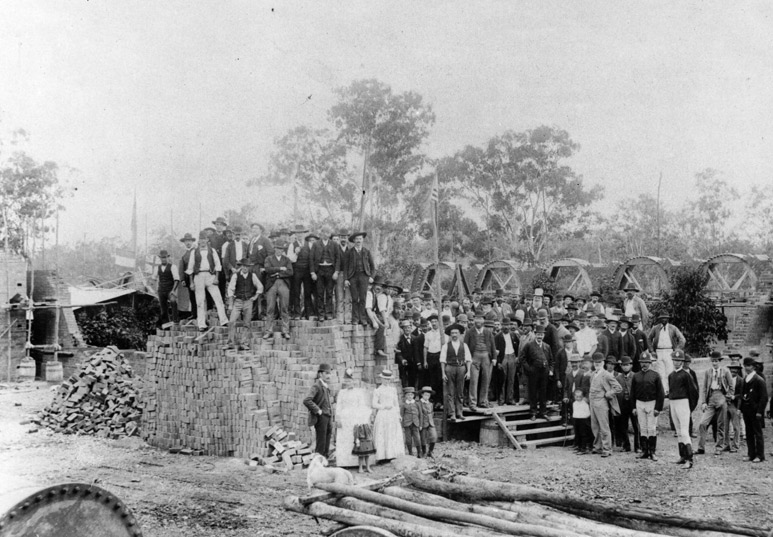Flashback Fridays: Birth of the System

Prior to separation from NSW in 1859 water in Queensland was sourced from private ponds, wells or from waterways and private industry played a key role in the form of water carriers. In Brisbane a small storage fed by local runoff and streams was established in Tank Street by 1838. A rudimentary reticulation system using hollow logs as pipes was installed to service the Officer’s barracks and Commandant’s headquarters of the small penal settlement. The storage was subject to contamination from runoff, particularly problematical in a growing city with no organised sewage disposal and with the ubiquitous presence of horses for transport and power.
Contamination increased over the next 20 years and a letter to the local newspaper, the Moreton Bay Courier early in the year of separation complained that the storage contained “a combination of animal and vegetable matter, which with the stewing from the sunshine, the visits from the quadrupeds, and the dragging of the buckets of the water-carriers, threatens to become the hole of death to those who, in this hot country, are compelled to drink the filthy compound.” (Powell 1991)
It may seem unusual now that almost 10 years after minimum water quality standards had been introduced in London, and around the same time that Paris and London were being sewered, Brisbane and other major towns still used contaminated supplies and illness and disease were common, particularly in summer months. However, in 1859 germ theory had not yet been proven (Pasteur undertook his ground-breaking experiments between 1860 and 1864) and the link between effluent contamination, drinking water quality and public disease outbreak was known, but not understood.
Installation of reticulated supplies depended on community demand for convenient services and aesthetically pleasing supplies to fortify the will of the government for a large capital outlay. The distance of the towns from the seat of power in Sydney was a cause for constant concern.
“Maddened by the lack of interest shown by the Sydney authorities, Brisbane’s residents had felt fully justified in calling for more local control to rectify the problems of their growing town. The appalling state of the water supply, streets and ferry approaches seemed to underline the wisdom of the old principle - no permanent improvement without local responsibility.” (Powell 1991)
The adversarial negotiation process between individual towns and the Government was already established and intensified as Queensland separated from the huge NSW colony. However, the new State was large, broke, and unprepared for the magnitude of the problem of providing even basic water (let alone sewerage) services.
The small initial population meant that return on investment for water infrastructure would be impossible in all but the largest settlements and it was not possible to privatise (as had been done in Britain) because the capital could not readily be raised in a fledgling state with dispersed and isolated communities.
It was becoming clear that water services would need the combined efforts of local and state governing bodies but how this system might work was still a matter of debate.
The first part of the 21st century has seen a dramatic breakdown of cordial arrangements between the State and local bodies responsible for ensuring safe, sustainable and secure water and sewerage services to Queensland communities. These changes followed a long period of active collaboration between the two levels of government, but during the start-up period of the industry in the 19th Century, disagreement was more common than cooperation.
The importance that institutional arrangements played in the development of the urban water industry is demonstrated by the speed with which local authorities commenced building waterworks following their formation. Municipalities such as Brisbane, Ipswich and Rockhampton moved to address their water supply issues immediately upon being proclaimed. Others (e.g. Toowoomba, Warwick and Maryborough) followed suit soon after, but were at least partly motivated by a desire to keep up with their neighbours and ensure they received equivalent funding to that being loaned to the larger towns.
Competition amongst regional councils was common and was exacerbated at the time by a combative approach to selecting a capital city. Many towns including Maryborough, Gayndah, Ipswich and Brisbane vied for and were considered as sites for the new capital, but most were excluded for need of port facilities.
In a similar vein, there were repeated campaigns to separate central and northern Queensland as distinct Australian states. Rivalry among individual municipalities and regions was a feature of institutional arrangements from the inception of the councils. We are lucky such animosities are things of the past.
In the early days of Queensland’s urban water industry, the interactions between local councils and the Queensland Government were where confrontation was most visible. An oscillation between collaborative and antagonistic interactions between the new municipalities and the State was to dominate the early years of the development of urban water supplies.
Next week: Tripartite Government and Water
Back to list